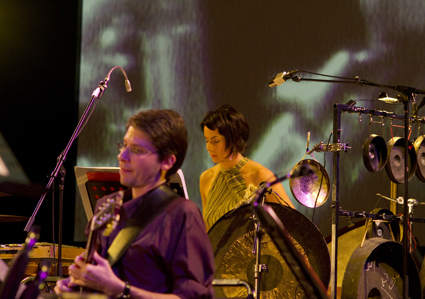tripping joy time
felicity clark: ensemble offspring, professor bad trip

Ensemble Offspring, Professor Bad Trip
photo Oliver Miller
Ensemble Offspring, Professor Bad Trip
DOOF DOOF DOOF DOOF, nnSe nnSe nnSe nnSe…IN THE ABSENCE OF POPULAR MUSIC’S MOST UBIQUITOUS QUALITY, METRIC BEAT, ENSEMBLE OFFSPRING’S LATEST CLASSICAL PROGRAM, PROFESSOR BAD TRIP, DREW PARALLELS WITH ITS PALTRY YOUNGER SIBLING, POP, USING ASSOCIATIONS OF TIMBRE. SUPERSATURATED AND DISTORTED ELECTRIC GUITARS, BASS AND DRUM-KIT DROVE MUSICAL FRAGMENTS ALONG, NEVER AIMING TO ARRIVE ANYWHERE, JUST TRIPPING.
Ensemble Offspring regulars teamed with guests Zane Banks on electric guitar, Dave Symes on bass, Ngaire de Korte on oboe, Rob Llewellyn on bassoon and Alex Bieri on trumpet to explore the divide and crossovers between classical and popular music. None of the works in the program were derivative of popular music but, instead, asserted classical music’s currency. Each showed that classical music can attune to the modern world while simultaneously transcending the form’s perceived limitations. In a packed Bay 20 at CarriageWorks the audience took a trip to the future of classical music. Our psychoactive tendencies were polled in an audience survey that asked us to name our hallucinogen of choice: Peyote, mushrooms, LSD or nutmeg.
Early in the program “Study for String Instrument #2” by fan of allspice and composer Simon Steen-Andersen raised the whammy pedal onto a classical pedestal. The pedal’s sound-modifications are unusually scored for a separate player from the string instrumentalist. It was performed by the fantastically frenzied Geoff Gartner on cello with ‘whammy assistant’ Adrian Bertram. Gartner played mad glissandi; he bowed the edge of the cello rather than the strings while tapping the instrument’s body to produce wild effects. I heard battling space gerbils, while Ensemble Offspring’s Damien Ricketson called the study’s ludicrously exaggerated language “a grotesque caricature of itself.”
Australian Matthew Shlomowitz’s “Joy Time Ride for Ives” parodied art music’s relationship with the musical cliché. Schlomowitz challenges the prevalent aesthetic in classical music that once a musical idea or motif is overused it’s no longer artistically classy. Instead he makes cliché the focus of this composition, exercising snippets of rock beat on drum-kit and recurring flourishes through the upper woodwinds. The repeated fragments are attention grabbing and a little jolting. It’s a relief to hear a familiar passage but you feel luxuriantly trashy enjoying something that’s been sounded so many times before. Cliché winSe nnSe nnSe.
The central works of the evening though were the three “Lessons” of Fausto Romitelli’s “Professor Bad Trip.” Inspired by the mescaline-fuelled poetry of Henri Michaux and the mind-bending drawings of Gianluca Lerici, aka Professor Bad Trip, Romitelli’s exploration of psychedelia is hallucinatory. In the broadest sense, hallucination is perception in the absence of stimulus—it’s the invention of something greater than what is really there. Each “Lesson” does just that. It breathes. It heaves. The music expands and contracts in such extraordinary plays with time that it’s as though universes are born and die with each surging sound. Time actually alters when you’re listening to this music.
“Ever since I was born, I have been immersed in digitalised images, synthetic sounds, artefacts,” the late Romitelli had explained. “Artificial, distorted, filtered—this is the nature of man today.” With this acceptance of the modern racket Romitelli’s sound world draws careful inspiration from disparate sources: from Ligeti to rock, electro and techno. He considered sound to be “a material into which one plunges in order to forge its physical and perceptive characteristics: grain, thickness, porosity, luminosity, density and elasticity.” Romitelli’s music is sculpture of sound, instrumental synthesis, transformation of spectral morphology. It’s in constant drift towards unsustainable densities, distortions and interferences. When I was able to escape the waves of immersion in his music for long enough to reflect, the phrase “an acoustic Aphex Twin” kept surfacing.
Video projections repositioned the audience’s attention out of the music and back onto the musicians. It assured we stay present, but was unnecessary for the majority of the time as the musicians were doing such a good job of transmitting the music that their bodies became superfluous to the art in action. Occasionally the filming caught a facial expression of concentration or communication that would otherwise have been invisible and this invited us deeper into their practice. It also reminded us to change our focus—in seeing someone new, we heard something new. Comedian Bill Bailey describes his experiences on acid as spending hours noticing ever more detail in the few things positioned beside him. He says while darting his head about, “Oh that’s quite interesting, that’s quite interesting, yes, that’s quite interesting.” Visuals, here, revealed the momentarily invisible points of interest.
As I left with an uncanny desire to bake spiced cookies, I thanked these musicians for creating a space for this music to be heard, inhaled, versed, warped, wet, born, aired…Who needs drugs anyway? Just as Ensemble Offspring had assured us in its pre-concert hype, I’ve been changed by this music. New music isn’t what it used to be.
Ensemble Offspring, Professor Bad Trip: Mind Altering Classical Music, conductor Roland Peelman, flute Lamorna Nightingale, clarinet Jason Noble, oboe Ngaire de Korte, bassoon Rob Llewellyn, trumpet Alex Bieri, keyboards Zubin Kanga, percussion Claire Edwardes, violin James Cuddeford and Veronique Serret, viola James Eccles, cello Geoffrey Gartner, double and electric bass Dave Symes, electric guitar Zane Banks, electronics Adrian Bertram, sound Bob Scott, lighting Neil Simpson, video Sean Bacon, Bay 20, CarriageWorks, Sydney, June 18
RealTime issue #104 Aug-Sept 2011 pg. 47






